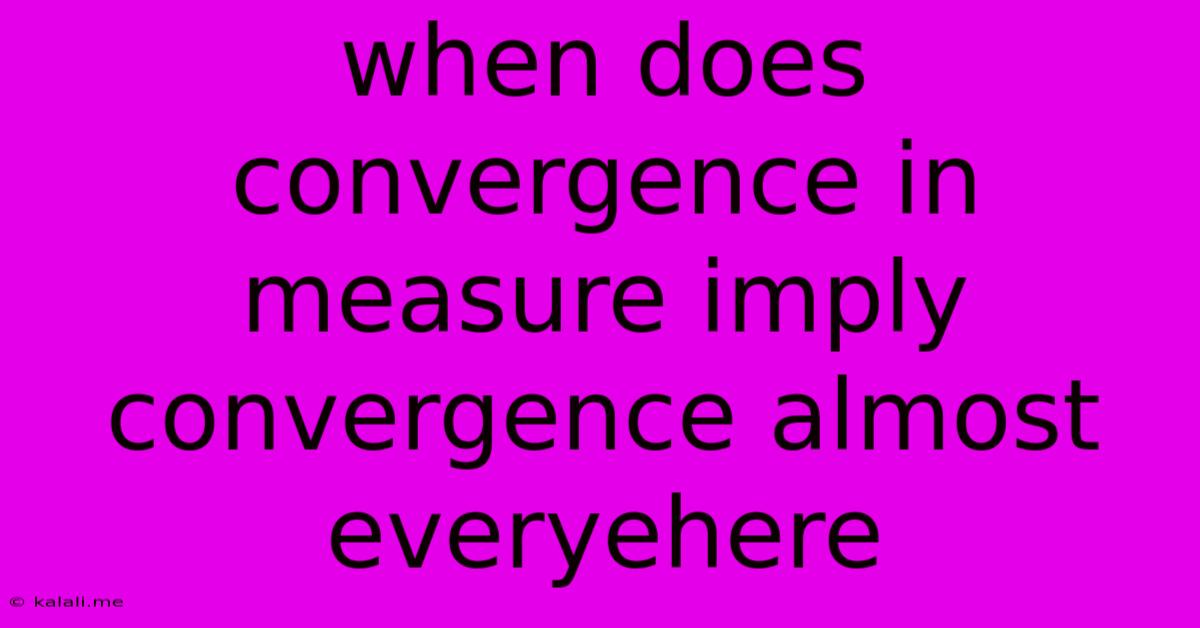When Does Convergence In Measure Imply Convergence Almost Everyehere
Kalali
May 24, 2025 · 3 min read

Table of Contents
When Does Convergence in Measure Imply Convergence Almost Everywhere?
Convergence in measure and convergence almost everywhere are two important concepts in measure theory, particularly relevant in probability and analysis. While they are related, they are not equivalent. This article explores the conditions under which convergence in measure implies convergence almost everywhere, focusing on the crucial role of subsequences and the implications for various applications. Understanding this relationship is vital for comprehending the nuances of limit theorems and functional analysis.
Convergence in Measure: A sequence of measurable functions {fₙ} converges in measure to a function f on a measure space (X, Σ, μ) if for every ε > 0, lim (n→∞) μ({x ∈ X : |fₙ(x) - f(x)| ≥ ε}) = 0. This means that the measure of the set where the difference between fₙ and f exceeds ε becomes arbitrarily small as n approaches infinity.
Convergence Almost Everywhere: A sequence of measurable functions {fₙ} converges almost everywhere (a.e.) to a function f if there exists a set E ∈ Σ with μ(E) = 0 such that lim (n→∞) fₙ(x) = f(x) for all x ∈ X \ E. This implies pointwise convergence everywhere except on a set of measure zero.
The Key Difference and the Connection: The core distinction lies in the order of the quantifiers. Convergence almost everywhere ensures pointwise convergence for almost all x, while convergence in measure only guarantees that the measure of the set where the functions differ significantly shrinks to zero. This subtle difference means convergence in measure is a weaker condition.
Does Convergence in Measure Always Imply Convergence Almost Everywhere?
No, convergence in measure does not always imply convergence almost everywhere. A simple counterexample illustrates this: Consider the sequence of functions {fₙ} on the interval [0, 1] with Lebesgue measure, where fₙ(x) = 1 if x ∈ [0, 1/n] and fₙ(x) = 0 otherwise. This sequence converges to f(x) = 0 in measure, but it does not converge to 0 almost everywhere because fₙ(x) = 1 for all x in [0, 1/n] regardless of how large n is.
When Does Implication Hold? The Role of Subsequences
While a direct implication doesn't always hold, a crucial result establishes a connection through subsequences: If a sequence {fₙ} converges to f in measure, then there exists a subsequence {fₙₖ} that converges to f almost everywhere. This is a powerful theorem. It demonstrates that even though the entire sequence might not converge almost everywhere, we can always extract a subsequence that does. This is often sufficient for many applications.
Practical Implications and Applications
This nuance between convergence in measure and almost everywhere convergence is significant in several areas:
-
Probability Theory: In probability, convergence in measure corresponds to convergence in probability, while almost everywhere convergence corresponds to almost sure convergence. The relationship between these modes of convergence is crucial in understanding limit theorems like the Strong Law of Large Numbers.
-
Functional Analysis: The concept of convergence in measure plays a role in the study of various function spaces and their properties. Understanding the relationship with almost everywhere convergence helps in characterizing completeness and other topological features of these spaces.
-
Numerical Analysis: When approximating functions or solutions to differential equations, understanding convergence in measure and almost everywhere convergence is crucial for assessing the accuracy and reliability of numerical methods.
Conclusion: While convergence in measure doesn't guarantee convergence almost everywhere for the entire sequence, the existence of a subsequence that converges almost everywhere is a significant result. This understanding is crucial in various mathematical fields, emphasizing the importance of carefully considering the type of convergence when working with sequences of functions. The subtleties of these concepts are key to deeper understanding of limit theorems and functional analysis.
Latest Posts
Latest Posts
-
My Family And I Are Vegetarians
May 24, 2025
-
How To Remove Bathroom Sink Drain
May 24, 2025
-
Pokerogue Can Eternatus Run Out Of Pp
May 24, 2025
-
Can You Plug An Extension Cord Into A Power Strip
May 24, 2025
-
How To Remove Paint From Wood Floor
May 24, 2025
Related Post
Thank you for visiting our website which covers about When Does Convergence In Measure Imply Convergence Almost Everyehere . We hope the information provided has been useful to you. Feel free to contact us if you have any questions or need further assistance. See you next time and don't miss to bookmark.